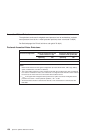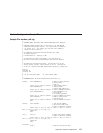
Configuration File Selection
Use the following steps to select a configuration file:
1. Is your modem an IBM 7852-400?
If Yes, use modem configuration file modem_m0.cfg and go to step 7 on page 165.
Note: The IBM 7852-400 modem has DIP switches on the right side of the unit.
See “IBM 7852-400 DIP Switch Settings” on page 166 for the correct switch
settings.
If No, continue with step 2.
2. Is your modem an IBM 7857-017?
If Yes, use modem configuration file modem_m1.cfg and go to step 7 on page 165.
Note: The IBM 7857-017 modem has two telephone line connections on the back
of the unit. One is marked LL (for Leased Line), and the other is marked
PTSN (for Public Telephone Switched Network). The service processor
expects to use the modem on the public network, so the telephone line
should attach to the PTSN connector.
If No, continue with step 3.
3. Does your modem respond to the extended command set (prefixed with &)?
If Yes, go to step 5. If No, continue with step 4.
4. Does your modem respond to:
v ATZ reset command
or
v ATZ
n
reset commands, where
n
can be 0, 1, and so on?
If ATZ, configuration file modem_z.cfg is recommended. If ATZ
n
, configuration
file modem_z0.cfg is recommended.
Go to step 7 on page 165.
5. Does your modem command set include a test for V.42 error correction at the
remote modem (often called “Auto-Reliable Mode”)?
If Yes, disable this test. You can use sample configuration files
/usr/share/modem_m0.cfg or /usr/share/modem_m1.cfg as models to help you
create a file for your particular modem. See “Customizing the Modem Configuration
Files” on page 166 for more information. Go to step 7 on page 165.
If No, go to step 6.
6. Does your modem respond to:
v AT&F reset command
or
v AT&F
n
reset commands, where
n
can be 0, 1, and so on?
If AT&F, configuration file modem_f.cfg is recommended. If AT&F
n
, configuration
file modem_f0.cfg or modem_f1.cfg is recommended, depending on which
provides the hardware flow control profile.
164 Eserver pSeries 690 User’s Guide


















